Carol Baldwin's Blog, page 55
April 6, 2015
Extraordinary: A Review and an ARC Giveaway!
In some ways books are like babies: conceiving them and bringing them into the world requires a lot of effort. The mother (writer) does most of the work, but there’s usually a team that assists with the delivery.
As the critique coordinator for the SCBWI Carolinas Charlotte group for over twenty years, I had the privilege of helping several fellow writers "deliver" their books. Whenever they did, I’ve been as proud as an aunt and enjoy celebrating the arrival of their “babies.”
You heard about Linda Phillips’ book Crazy last fall and now it’s Miriam Franklin’s turn. Both authors brought their books through one laborious draft after another until their stories emerged- beautifully formed and ready for a world of readers.
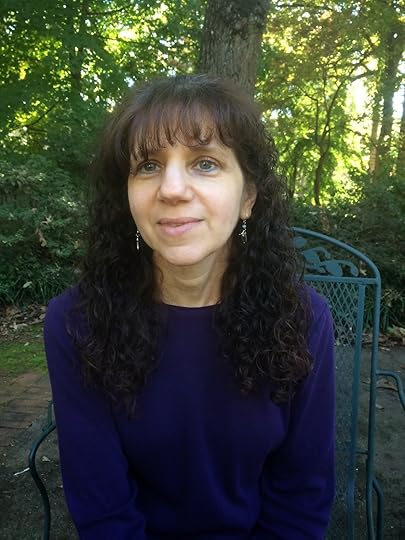
Over ten years I read several drafts of Miriam’s debut novel Extraordinary (Sky Pony Press, May 2015). In each one the kernel was the same: Ten-year-old Pansy's best friend, Anna, develops meningitis after a spring break camp. Pansy decides that if she becomes extraordinary, Anna will forgive her for all the promises she didn't keep. “Extraordinary” Pansy also wants to be the first person Anna sees after her brain surgery that hopefully will reduce her seizures.
Pansy’s wishful thinking—that she and Anna will return to the days of swimming at the beach, playing LEGOs with Anna’s twin brother Andy, and being Girl Scouts together—is not uncommon for children and adults when facing tragedy.
Pansy hasn’t forgiven herself since she backed out of her promise to Anna to attend camp over spring break. Pansy got scared, the two girls fought, and Anna slammed the door behind Pansy. The next time she saw Anna, her friend was in a hospital bed. "Anna couldn't talk, she couldn't understand what people were saying, and she didn't act like she knew me at all." (p.3)
While going for a hike with Andy, she thinks about how his family had to stay home with Anna. "You couldn't push a wheelchair on a trail in the mountains." (p. 86)
Pansy doesn't want to admit her fears:
Before Anna's brain surgery Pansy reflects,
*********Miriam Franklin has captured a difficult topic for young readers to understand: how do you respond when your best friend suffers a serious illness. I hope you will consider pre-ordering this well-written book for yourself, or for a young reader in your life. This will be a perfect book for families who have experienced similar tragedies and will speak to adults as well as children. As Angela Ackerman said in a recent blog, this book is very relatable.
Leave me a comment by 7 PM on April 8 if you would like to receive my gently used copy of this ARC. If I don't have your email address, please make sure you leave that also. If you become a new follower of my blog or post this to your social media of choice, I'll enter your name twice--just make sure you let me know what you do.

As the critique coordinator for the SCBWI Carolinas Charlotte group for over twenty years, I had the privilege of helping several fellow writers "deliver" their books. Whenever they did, I’ve been as proud as an aunt and enjoy celebrating the arrival of their “babies.”
You heard about Linda Phillips’ book Crazy last fall and now it’s Miriam Franklin’s turn. Both authors brought their books through one laborious draft after another until their stories emerged- beautifully formed and ready for a world of readers.

Over ten years I read several drafts of Miriam’s debut novel Extraordinary (Sky Pony Press, May 2015). In each one the kernel was the same: Ten-year-old Pansy's best friend, Anna, develops meningitis after a spring break camp. Pansy decides that if she becomes extraordinary, Anna will forgive her for all the promises she didn't keep. “Extraordinary” Pansy also wants to be the first person Anna sees after her brain surgery that hopefully will reduce her seizures.
Pansy’s wishful thinking—that she and Anna will return to the days of swimming at the beach, playing LEGOs with Anna’s twin brother Andy, and being Girl Scouts together—is not uncommon for children and adults when facing tragedy.

Pansy hasn’t forgiven herself since she backed out of her promise to Anna to attend camp over spring break. Pansy got scared, the two girls fought, and Anna slammed the door behind Pansy. The next time she saw Anna, her friend was in a hospital bed. "Anna couldn't talk, she couldn't understand what people were saying, and she didn't act like she knew me at all." (p.3)
While going for a hike with Andy, she thinks about how his family had to stay home with Anna. "You couldn't push a wheelchair on a trail in the mountains." (p. 86)
Pansy doesn't want to admit her fears:
In the spring they'll come with us. I wanted to say. And Anna will win Poohsticks, like always, and she'll be the first one down the steps to the falls. But I kept my words inside. Maybe I was afraid to say them out loud, afraid they would just disappear as soon as they were out of my mouth--as if by telling someone else how I get, I might keep my hopes from coming true. (p. 86)The book is full of Pansy's efforts to become extraordinary in order to be the type of friend Anna deserves. Some of her actions have funny, unexpected consequences. For example, she attempts to improve her Rollerblading skills but ends up being pulled by two huge dogs around a park. But her drive to redeem herself for her failures and be an extraordinary friend propels her forward.
Before Anna's brain surgery Pansy reflects,
No matter how worried or nervous I was, Anna always believed in me. And I knew she still did. I would never have put on skates, gone to the top of the list for Independent Reader, or joined Girl Scouts if it weren't for Anna. But now, it was my turn to be there for her. To believe that she as going to pull through this surgery, that she was going to come out of it stronger than ever before. That she was going to be Anna again and that she would be so proud of me for all I'd done. So I blocked out all those questions and concentrated on one thing: in less than two weeks, I'd be sure to have my best friend back. (p. 151)Pansy can't wait to see Anna after her surgery. She's heard that it was successful and she goes to the hospital armed with high hopes, a balloon, and a box of Oreos--Anna's favorite. Pansy is stunned at her friend's appearance and behavior:
She just lay there, her head drooping down, her eyes poking lifeless. She didn't seem to care if I was there or not. (p.196)When Anna drops her hand on the package of cookies, her family is ecstatic because she's finally using her right hand. But for Pansy, all is lost.
I'd imagined it all--Anna understanding my words when I told her about my goals, Anna looking at my badge and getting that I'd earned it for her. Now I knew that Anna hadn't understood that I was doing any of those things for her.
All my dreams about Anna's recovery instantly evaporated into the air. They were just dreams. That's all they were. (p.198)Pansy wrestles with the hard facts of Anna's illness and discovers that by following Anna's brave example she can conquer some of her own fears. In that way, Pansy finds her own path to extraordinary.
*********Miriam Franklin has captured a difficult topic for young readers to understand: how do you respond when your best friend suffers a serious illness. I hope you will consider pre-ordering this well-written book for yourself, or for a young reader in your life. This will be a perfect book for families who have experienced similar tragedies and will speak to adults as well as children. As Angela Ackerman said in a recent blog, this book is very relatable.
Leave me a comment by 7 PM on April 8 if you would like to receive my gently used copy of this ARC. If I don't have your email address, please make sure you leave that also. If you become a new follower of my blog or post this to your social media of choice, I'll enter your name twice--just make sure you let me know what you do.
Published on April 06, 2015 04:58
March 30, 2015
Writing Tips #5: Nuggets of Wisdom on Editing & Revision
Congratulations to Kathy Weichman who won Beginnings Middles & Ends by Nancy Kress. Thanks to all of you who contributed to the this series. You can find the previous posts here: Part I and II included General Advice; Part III was on Deep Point of View; and Part IV was on Story Making. *******
"During my time as a facilitator of various writing groups, I saw the tendency of overusing the words ‘that’ and ‘was’.THAT is a word THAT should not be used THAT often. It is reasonable to say, eighty percent of that’s are not necessary.
"WAS is another overused word that takes away from the action. I once had a writing assignment in college where the professor wanted a two thousand word story written without the use of ‘was.' Almost impossible to do. Try replacing 'was' with action words or dialogue. If you use it more than ten times in a two thousand word story, you are abusing the word.
"Misplacing a comma can turn the meaning of a sentence into something other than intended. Always place a comma before a person’s name when used in dialogue.
“Let’s go out and eat Nancy.” “Let’s go out and eat, Nancy.”
"In the first example, it looks like Nancy is dinner. In the second example, with the comma before Nancy’s name, the meaning isn’t so graphic." Tommy Styles, short story writer.
"Editing will require you to kill phrases, paragraphs, maybe even entire chapters or characters that you love. Sometimes they’ll be the bits you think are clever and beautiful and certain to be the ones your fans will be quoting and sharing on social media. You must be willing to do it anyway. You must learn to become brutally analytical about your own work. If it doesn’t help the story, it is not necessary. Period." Shannon Wiersbitzky, author of What Flowers Remember.

"I am beginning an extensive revision and working hard to cut what needs to be cut, but it helps to remember that what is cut doesn't need to be trashed. It can be saved to be used another day. Maybe it won't, but it's easier to cut when I have that mindset." Kathy Cannon Wiechman, author of Like A River.
"When you cutting, words, sentences, paragraphs don't just throw them away. That's too emotional for many of us. Open a "shards" or "discards" file for each WIP and save those cuttings. You'll be able to use them another day in another project." Jean Hall, founder of Write2Ignite.
"Writing and publishing is a long-term pursuit, so don't rush what you are working on, and don't submit before it is polished. Revision is the key to publication." Christine Kohler, author of No Surrender Soldier. Found on http://madwomanintheforest.com/wfmad-...
Found on http://madwomanintheforest.com/wfmad-...
"Put away your work for a good while before revising." Rosi Hollenbeck, SCBWI critique group coordinator for Northern and Central California and blogger.
"There comes a time to put down the writing books, the notes from conferences and classes, the "he said she said" telling you what to do or not to do and JUST WRITE THE STORY THAT'S IN YOUR HEART. Sandra Warren, author of Arlie the Alligator.
If you need more inspiration, check out Janice Hardy's month of outstanding at-home revision blogs. Kathy Temean has an excellent list of things not to miss when editing your work. And here are some top editing and proofreading tips from the folks at Romance University.
Finally, here is advice from a fourth-grade teacher; I use this quote whenever I teach writing: "The red pencil is your best friend."
"During my time as a facilitator of various writing groups, I saw the tendency of overusing the words ‘that’ and ‘was’.THAT is a word THAT should not be used THAT often. It is reasonable to say, eighty percent of that’s are not necessary.
"WAS is another overused word that takes away from the action. I once had a writing assignment in college where the professor wanted a two thousand word story written without the use of ‘was.' Almost impossible to do. Try replacing 'was' with action words or dialogue. If you use it more than ten times in a two thousand word story, you are abusing the word.
"Misplacing a comma can turn the meaning of a sentence into something other than intended. Always place a comma before a person’s name when used in dialogue.
“Let’s go out and eat Nancy.” “Let’s go out and eat, Nancy.”
"In the first example, it looks like Nancy is dinner. In the second example, with the comma before Nancy’s name, the meaning isn’t so graphic." Tommy Styles, short story writer.
"Editing will require you to kill phrases, paragraphs, maybe even entire chapters or characters that you love. Sometimes they’ll be the bits you think are clever and beautiful and certain to be the ones your fans will be quoting and sharing on social media. You must be willing to do it anyway. You must learn to become brutally analytical about your own work. If it doesn’t help the story, it is not necessary. Period." Shannon Wiersbitzky, author of What Flowers Remember.

"I am beginning an extensive revision and working hard to cut what needs to be cut, but it helps to remember that what is cut doesn't need to be trashed. It can be saved to be used another day. Maybe it won't, but it's easier to cut when I have that mindset." Kathy Cannon Wiechman, author of Like A River.
"When you cutting, words, sentences, paragraphs don't just throw them away. That's too emotional for many of us. Open a "shards" or "discards" file for each WIP and save those cuttings. You'll be able to use them another day in another project." Jean Hall, founder of Write2Ignite.
"Writing and publishing is a long-term pursuit, so don't rush what you are working on, and don't submit before it is polished. Revision is the key to publication." Christine Kohler, author of No Surrender Soldier.
 Found on http://madwomanintheforest.com/wfmad-...
Found on http://madwomanintheforest.com/wfmad-... "Put away your work for a good while before revising." Rosi Hollenbeck, SCBWI critique group coordinator for Northern and Central California and blogger.
"There comes a time to put down the writing books, the notes from conferences and classes, the "he said she said" telling you what to do or not to do and JUST WRITE THE STORY THAT'S IN YOUR HEART. Sandra Warren, author of Arlie the Alligator.
If you need more inspiration, check out Janice Hardy's month of outstanding at-home revision blogs. Kathy Temean has an excellent list of things not to miss when editing your work. And here are some top editing and proofreading tips from the folks at Romance University.

Finally, here is advice from a fourth-grade teacher; I use this quote whenever I teach writing: "The red pencil is your best friend."
Published on March 30, 2015 06:02
March 24, 2015
Writing Tips #4 - Nuggets of Wisdom on Story Making
Congratulations to Connie Saunders who won a copy of Kathy Weichman's book, Like A River.
As promised, I'm returning to my mini-series of posts on Writing Tips. If you missed the earlier posts, Part I and II included General Advice and Part III was on Deep Point of View. Today, some of my fellow writers tackle story making.
*******
"I spend time lying in bed late at night just before nodding off or first thing in the morning before I'm really awake, mulling over my characters and their motivations and my story line. I love it!" Kim Van Sickler, author of Snatched in Gullybrook.
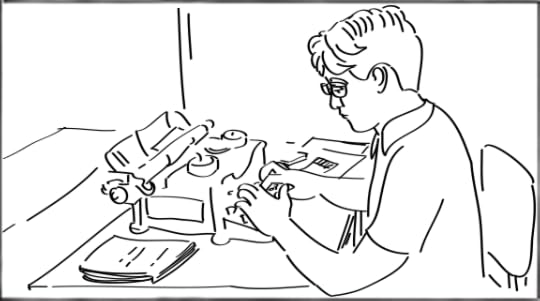 From: http://www.onstory.tv/interact/making... ways to engage your reader from Martina Boone's blog Adventures in YA Publishing: Set out the stakes early.Start with the story question.Keep your main character in the forefront by engaging her/him in activity.Reveal character and special abilities through action as much as possible.Build the story world as you go, slivering in the details of place as needed.Martina adds, "Put the core of the story on every page—the thing that you wouldn’t change no matter what. That needs to be there from the first paragraph to the last. It may or may not be the story question. Perhaps it’s voice, or setting, or a character, a style, a mood. Whatever it is that makes the story important to you, start with it, end with it, and carry it through the book. Chances are that will make the story truly yours and that’s what will separate it from others in the slush pile and on the bookstore shelves." Martina Boone is the author of
Compulsion.
From: http://www.onstory.tv/interact/making... ways to engage your reader from Martina Boone's blog Adventures in YA Publishing: Set out the stakes early.Start with the story question.Keep your main character in the forefront by engaging her/him in activity.Reveal character and special abilities through action as much as possible.Build the story world as you go, slivering in the details of place as needed.Martina adds, "Put the core of the story on every page—the thing that you wouldn’t change no matter what. That needs to be there from the first paragraph to the last. It may or may not be the story question. Perhaps it’s voice, or setting, or a character, a style, a mood. Whatever it is that makes the story important to you, start with it, end with it, and carry it through the book. Chances are that will make the story truly yours and that’s what will separate it from others in the slush pile and on the bookstore shelves." Martina Boone is the author of
Compulsion.
"If you are writing for teens, surround yourself with that age group and ask questions, look at their fashion statements, find out their interests. Listening to conversations with their peers is helpful in writing dialogue and understanding their issues. Words I use are sometimes out of date and they give me the new slang term." Sheri Levy is the author of Seven Days to Goodbye.
 http://www.clipartsalbum.com/?l=globa...
http://www.clipartsalbum.com/?l=globa...
Finally, here are two excellent posts by Katia Raina on plot and structure.
********Next week I'll finish this series with a post on revision and will announce the winner of Nancy Kress's book: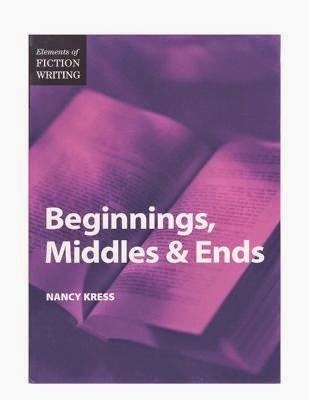

As promised, I'm returning to my mini-series of posts on Writing Tips. If you missed the earlier posts, Part I and II included General Advice and Part III was on Deep Point of View. Today, some of my fellow writers tackle story making.
*******
"I spend time lying in bed late at night just before nodding off or first thing in the morning before I'm really awake, mulling over my characters and their motivations and my story line. I love it!" Kim Van Sickler, author of Snatched in Gullybrook.
 From: http://www.onstory.tv/interact/making... ways to engage your reader from Martina Boone's blog Adventures in YA Publishing: Set out the stakes early.Start with the story question.Keep your main character in the forefront by engaging her/him in activity.Reveal character and special abilities through action as much as possible.Build the story world as you go, slivering in the details of place as needed.Martina adds, "Put the core of the story on every page—the thing that you wouldn’t change no matter what. That needs to be there from the first paragraph to the last. It may or may not be the story question. Perhaps it’s voice, or setting, or a character, a style, a mood. Whatever it is that makes the story important to you, start with it, end with it, and carry it through the book. Chances are that will make the story truly yours and that’s what will separate it from others in the slush pile and on the bookstore shelves." Martina Boone is the author of
Compulsion.
From: http://www.onstory.tv/interact/making... ways to engage your reader from Martina Boone's blog Adventures in YA Publishing: Set out the stakes early.Start with the story question.Keep your main character in the forefront by engaging her/him in activity.Reveal character and special abilities through action as much as possible.Build the story world as you go, slivering in the details of place as needed.Martina adds, "Put the core of the story on every page—the thing that you wouldn’t change no matter what. That needs to be there from the first paragraph to the last. It may or may not be the story question. Perhaps it’s voice, or setting, or a character, a style, a mood. Whatever it is that makes the story important to you, start with it, end with it, and carry it through the book. Chances are that will make the story truly yours and that’s what will separate it from others in the slush pile and on the bookstore shelves." Martina Boone is the author of
Compulsion.
"If you are writing for teens, surround yourself with that age group and ask questions, look at their fashion statements, find out their interests. Listening to conversations with their peers is helpful in writing dialogue and understanding their issues. Words I use are sometimes out of date and they give me the new slang term." Sheri Levy is the author of Seven Days to Goodbye.
 http://www.clipartsalbum.com/?l=globa...
http://www.clipartsalbum.com/?l=globa...Finally, here are two excellent posts by Katia Raina on plot and structure.
********Next week I'll finish this series with a post on revision and will announce the winner of Nancy Kress's book:

Published on March 24, 2015 08:12
March 18, 2015
You Heard it Here First: Introducing "Like a River" by Kathy Cannon Wiechman
One of my blogging joys is introducing an author or illustrator who is making her debut. It is my pleasure to review Like A River by Kathy Cannon Weichman which makes its official debut in April. At the end of this blog you'll find directions on how you can win my ARC (Advanced Reader Copy).

******Although this interchange between Polly (alias Paul Settles) and a trusted doctor comes at the end of this middle grade civil war book, it's a marvelous summary. Told from the perspectives of both protagonists, this well-researched work will entertain and educate both girls and boys.
Part One, Leander Jordan's story, opens with this 15-year-old boy longing to be recognized as a man by his parents and Lila, the girl he pines after. He decides that the best way to do that will be to enlist and gain their approval. It's not as simple as that. Wiechman portrays his dilemma on the sleepless night before Leander leaves his Ohio home: "Doubts crowded into bed beside him, and he tried to push them out." (p.51)
His life as a soldier isn't easy and his small stature makes him a brunt of frequent jokes. As much as he desires to be brave and show that he is equal to the task, early in his enlistment he accidentally causes his gun to explode. He injures himself and his best friend, Given; the pain of his humiliation is almost as great as his physical pain. Wiechman depicts his agony well:
Leander guesses that "Paul" is a girl but hesitates to disclose his knowledge. "He knew she was a girl, and maybe she suspected he knew, but he had to treat her like the soldier she pretended to be. She deserved that." (p.127)
When Leander wakes up one day and Paul has left the hospital with other Union soldiers, Leander "is stabbed through the heart." Part I ends with his realization that when he'd left his parents, he hadn't been a man at all. "I need to be a man, he thought. I can't let that girl-pretending-to-be-a-boy be more of a man than I am."
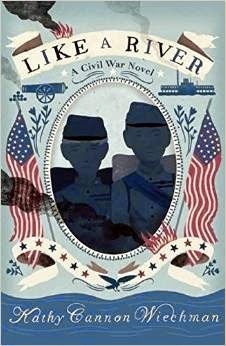
Part Two opens with Polly's difficult decision to leave Leander and the hospital. Stuffing her emotions inside she realizes, "The army had no place for a girl. And an orphaned girl had no place in the world. She had to remain a boy." (p. 138)
As part of a foraging mission, she is caught by a group of Rebs and her need to continue pretending she is a boy becomes more and more acute. Along with her three companions she is forced onto a train that brings them to Andersonville Prison. Wiechman does an excellent job showing what life was like in this stinking, dirty, fearful place:
Polly combats hunger, exhaustion, her own fears of being discovered, and sadness when her companions die. Throughout the story she yearns for Leander, wishing she had stayed with him months earlier. The last straw is when Given succumbs to scurvy and dysentery. She nurses him back to health and chooses to stay with him after Sherman takes Atlanta and a prison exchange occurs.
I've already told you too much about this heart-warming story so I won't reveal the beautiful ending. But you can bet that bravery, courage, and determination are the victors--and that you will want the story to keep on going even after "the end."
*******Joyce Hostetter and I are featuring an interview with Kathy Wiechman in our March issue of Talking Story. If you leave a comment on this blog I'll enter your name once to receive this ARC. Or, click here and send an email through the newsletter and I'll enter your name that way. Do both and your name is entered twice to win a great book you can use in your classroom, homeschool, or for your own enjoyment curriculum. Hurry! Giveaway ends on March 21. Make sure you leave me your email address if you're new to my blog.
Kathy is part of a group blog, Swagger. If you type in "Like a River" in the search function (top left) you'll find a list of posts she's written about her book. It's always inspiring to read other writers' book journeys.

Doc said, "he's not the same as the Leander who marched off. War changes folks."
"Like a river," Polly said. "My pap al'ys said folks is like rivers, ever a-changin' and ever a-changin' others."(p. 310)
******Although this interchange between Polly (alias Paul Settles) and a trusted doctor comes at the end of this middle grade civil war book, it's a marvelous summary. Told from the perspectives of both protagonists, this well-researched work will entertain and educate both girls and boys.
Part One, Leander Jordan's story, opens with this 15-year-old boy longing to be recognized as a man by his parents and Lila, the girl he pines after. He decides that the best way to do that will be to enlist and gain their approval. It's not as simple as that. Wiechman portrays his dilemma on the sleepless night before Leander leaves his Ohio home: "Doubts crowded into bed beside him, and he tried to push them out." (p.51)
His life as a soldier isn't easy and his small stature makes him a brunt of frequent jokes. As much as he desires to be brave and show that he is equal to the task, early in his enlistment he accidentally causes his gun to explode. He injures himself and his best friend, Given; the pain of his humiliation is almost as great as his physical pain. Wiechman depicts his agony well:
"Army life went on without him while he lay on a cot, alone and one-armed. There were no other cots because no one else was injured. There hadn't been a battle. Leander wasn't a casualty of war. He was a casualty of carelessness. He had dishonored his uniform…" (p. 79)Leander is full of self-loathing while he is recuperating in a makeshift army hospital. Paul Settles, a young, gentle steward nurses him and other wounded soldiers back to health. When Leander dictates a letter home, he finally accepts his injury.
"He had lost his arm. It was time to reconcile himself to that. And now he had confessed his carelessness to his folks. He had to accept his new life, one without Lila or his right arm. At least it was a life." (p.118)
Leander guesses that "Paul" is a girl but hesitates to disclose his knowledge. "He knew she was a girl, and maybe she suspected he knew, but he had to treat her like the soldier she pretended to be. She deserved that." (p.127)
When Leander wakes up one day and Paul has left the hospital with other Union soldiers, Leander "is stabbed through the heart." Part I ends with his realization that when he'd left his parents, he hadn't been a man at all. "I need to be a man, he thought. I can't let that girl-pretending-to-be-a-boy be more of a man than I am."

Part Two opens with Polly's difficult decision to leave Leander and the hospital. Stuffing her emotions inside she realizes, "The army had no place for a girl. And an orphaned girl had no place in the world. She had to remain a boy." (p. 138)
As part of a foraging mission, she is caught by a group of Rebs and her need to continue pretending she is a boy becomes more and more acute. Along with her three companions she is forced onto a train that brings them to Andersonville Prison. Wiechman does an excellent job showing what life was like in this stinking, dirty, fearful place:
The stockade was good-sized, close to twenty acres by Polly's guess, but its high walls managed to hold in every foul odor she could imagine. The filthy stench of human waste, disease, and rotting flesh pressed against her, while outside the walls those tall trees hoarded their piney scent.
Tents and makeshift shelters clustered nearly every inch of the camp, even two low hillsides that straddled a scummed-over stream. Thousands of shelters, some mere blankets on poles.
Polly hoped the nasty stream wasn't their drinking water. In the midst of a swamp, it was putrid green and reeked of human waste. A narrow channel at one end formed board "sinks," an open place for prisoners to answer nature's call. Alive with flies, the stream flowed through to catch the droppings.Since she worked in the hospital, Polly possesses rudimentary knowledge of disease and infection control. She finds purpose and meaning in her life by taking care of her companions. Along the way she finds friendship and shelter from a young man, Given, who guesses her secret, but promises not to tell anyone.
Polly combats hunger, exhaustion, her own fears of being discovered, and sadness when her companions die. Throughout the story she yearns for Leander, wishing she had stayed with him months earlier. The last straw is when Given succumbs to scurvy and dysentery. She nurses him back to health and chooses to stay with him after Sherman takes Atlanta and a prison exchange occurs.
I've already told you too much about this heart-warming story so I won't reveal the beautiful ending. But you can bet that bravery, courage, and determination are the victors--and that you will want the story to keep on going even after "the end."
*******Joyce Hostetter and I are featuring an interview with Kathy Wiechman in our March issue of Talking Story. If you leave a comment on this blog I'll enter your name once to receive this ARC. Or, click here and send an email through the newsletter and I'll enter your name that way. Do both and your name is entered twice to win a great book you can use in your classroom, homeschool, or for your own enjoyment curriculum. Hurry! Giveaway ends on March 21. Make sure you leave me your email address if you're new to my blog.
Kathy is part of a group blog, Swagger. If you type in "Like a River" in the search function (top left) you'll find a list of posts she's written about her book. It's always inspiring to read other writers' book journeys.
Published on March 18, 2015 10:19
March 9, 2015
Writing Tips #3- Nuggets of Wisdom on Deep Point of View
When I asked my writer friends for writing tips, I had no idea what they would send. I received lots of general advice, but also a few tidbits that I categorized. Today's post compiles ones on deep point of view.
I was first introduced to this concept during Lorin Oberweger's Free Expressions seminar. Lorin generously gave me permission to post this excellent handout, and in this blog I share some of my experiences at that workshop. Now I consciously look for how authors portray their protagonists' point of view.
To me, deep point of view is about filtering my character's world through her unique lens. Getting inside her skin and psyche. Feeling her anguish, fears, conflicts, joys, and thrills. Being as "up close and personal" as possible.
Even if that character happens to be a mouse.
 Image found on imgfave.comHere are some tips on how to accomplish this:
Image found on imgfave.comHere are some tips on how to accomplish this:
"Write from inside your character's head. You have to see what he sees and feel what he feels. If you want to fully pull a reader into your setting and story, this is vital. I write fiction, but I think this also applies to non-fiction, at least to some degree." Kathy Cannon Wiechman, author of Like a River.
"As the POV deepens, it becomes easier for the reader to completely immerse themselves in the story, in the character, and to forget that it is actually fiction.
"But how to achieve that? One good starting point is by taking away the “telling” part of thinking and saying, of seeing and watching, and simply “showing" us that instead.
"Here are a few examples using passages from my middle-grade novel What Flowers Remember.When our tears ended, Mama unwrapped me and pushed herself up from the couch. “How about I get us some toast with honey.” Mae reached back down into the bag. “That’s why we have gliiiitterrrr!” She sang the last word, stretching it out and draping it all over the room. Mrs. Williams folded up a nearby magazine and swatted him on the arm. “Sometimes it’s as if you were raised in a barn.” "Not a single “said” or “thought” in any of those…and while you might easily see where they could be added, why? Would it make the passage better? I’d argue no.
"I was mindful of trying to eliminate speech tags where I felt it worked, replacing them with body language or movement or some other action. All of which works to help readers not just understand what is happening, but to better visualize it." Shannon Wiersbitzky, author of The Summer of Hammers and Angels .
"Always consider the character’s needs, not the author's. What does the character see, feel, hear, think and how does she react. And to paraphrase both Donald Maass and Bruce Coville—although not sure they expected it to come together in quite this way—don’t take the obvious emotion first. Give readers the unexpected emotion--or the unexpected mix of emotional reactions--from the character, but don’t forget to let the reader know why the character is having that reaction. That doesn’t require a flashback, or even an explanation right then, but do make sure you give the reader what they need to know when they need to know it. Martina Boone, author of Compulsion .
"When writing point of view, imagine your main character is looking through a camera lens. The objective viewpoint would be seeing the world around him with a wide-angle or panoramic lens. The subjective viewpoint would be looking at things with a macro-lens, and taking lots of selfies." Christine Kohler, author of No Surrender Soldier , explains more about objective and subjective viewpoints in this article.
********Next week I'll be reviewing and giving away an ARC of Kathy Wiechman's debut novel, Like a River . After that will be two more posts in this "Writing Tips" series. The next is on story making and the last one is on revision. If you want to chime in on either topic, leave me a comment or send me an email at cbaldwin6@me.com. If I use your nugget, I'll add your name for a drawing to receive this book: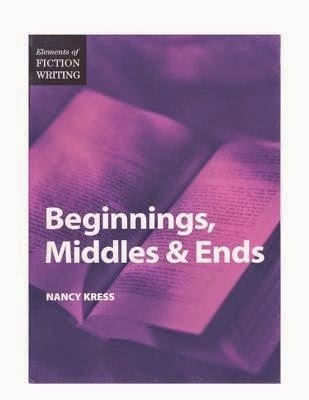

I was first introduced to this concept during Lorin Oberweger's Free Expressions seminar. Lorin generously gave me permission to post this excellent handout, and in this blog I share some of my experiences at that workshop. Now I consciously look for how authors portray their protagonists' point of view.
To me, deep point of view is about filtering my character's world through her unique lens. Getting inside her skin and psyche. Feeling her anguish, fears, conflicts, joys, and thrills. Being as "up close and personal" as possible.
Even if that character happens to be a mouse.
 Image found on imgfave.comHere are some tips on how to accomplish this:
Image found on imgfave.comHere are some tips on how to accomplish this:"Write from inside your character's head. You have to see what he sees and feel what he feels. If you want to fully pull a reader into your setting and story, this is vital. I write fiction, but I think this also applies to non-fiction, at least to some degree." Kathy Cannon Wiechman, author of Like a River.
"As the POV deepens, it becomes easier for the reader to completely immerse themselves in the story, in the character, and to forget that it is actually fiction.
"But how to achieve that? One good starting point is by taking away the “telling” part of thinking and saying, of seeing and watching, and simply “showing" us that instead.
"Here are a few examples using passages from my middle-grade novel What Flowers Remember.When our tears ended, Mama unwrapped me and pushed herself up from the couch. “How about I get us some toast with honey.” Mae reached back down into the bag. “That’s why we have gliiiitterrrr!” She sang the last word, stretching it out and draping it all over the room. Mrs. Williams folded up a nearby magazine and swatted him on the arm. “Sometimes it’s as if you were raised in a barn.” "Not a single “said” or “thought” in any of those…and while you might easily see where they could be added, why? Would it make the passage better? I’d argue no.
"I was mindful of trying to eliminate speech tags where I felt it worked, replacing them with body language or movement or some other action. All of which works to help readers not just understand what is happening, but to better visualize it." Shannon Wiersbitzky, author of The Summer of Hammers and Angels .
"Always consider the character’s needs, not the author's. What does the character see, feel, hear, think and how does she react. And to paraphrase both Donald Maass and Bruce Coville—although not sure they expected it to come together in quite this way—don’t take the obvious emotion first. Give readers the unexpected emotion--or the unexpected mix of emotional reactions--from the character, but don’t forget to let the reader know why the character is having that reaction. That doesn’t require a flashback, or even an explanation right then, but do make sure you give the reader what they need to know when they need to know it. Martina Boone, author of Compulsion .
"When writing point of view, imagine your main character is looking through a camera lens. The objective viewpoint would be seeing the world around him with a wide-angle or panoramic lens. The subjective viewpoint would be looking at things with a macro-lens, and taking lots of selfies." Christine Kohler, author of No Surrender Soldier , explains more about objective and subjective viewpoints in this article.
********Next week I'll be reviewing and giving away an ARC of Kathy Wiechman's debut novel, Like a River . After that will be two more posts in this "Writing Tips" series. The next is on story making and the last one is on revision. If you want to chime in on either topic, leave me a comment or send me an email at cbaldwin6@me.com. If I use your nugget, I'll add your name for a drawing to receive this book:

Published on March 09, 2015 05:17
March 2, 2015
Writing Tips #2: Nuggets of Wisdom From Writers to Writers
Continuing the discussion from last week, here are more tips generously shared by my writing friends.
General Advice Part II
"Write. If you are going to be a writer, you must write. Many people talk about writing, read books about writing, but do not write. Finish a story. Revise it for a particular market or for your own pleasure. Write daily because it is practice.
"Buy yourself a notebook, preferably one that you can take with you on walks or tuck into your medium sized purse, something that is not a burden but a pleasure. This way, you always have a chance to sit down and collect your thoughts no matter where you are. I find that writing for just 15-20 min a day keeps my writing muscles limber. Vijaya Bodach, author of the upcoming picture book, Ten Easter Eggs.
“Trust your process and never compare yourself to another writer, no good will ever come from that.” Holly Hughes
"Consider that thinking time is writing time, and it may even be more valuable in the end. Mine those moments in the shower where you talk to your character, or the discussion you and your protagonist have while cleaning the toilet. It might be handy to take along a small recorder in the car, to capture these thought-conversations. Take your protagonist (or antagonist for that matter) along to the grocery store and let them choose a few items. Watch how your characters deal with the gym, or church, the doctor’s office or a walk in the neighborhood. Now you are ready to write!" Linda Phillips, author of Crazy .
 From: http://cliparts.co/picture-of-person-... all you can about the submitting, publishing process and then persist, persist, persist! Believe in your story and never give up because if you do, you'll never know how close you came.
From: http://cliparts.co/picture-of-person-... all you can about the submitting, publishing process and then persist, persist, persist! Believe in your story and never give up because if you do, you'll never know how close you came.
"Be brave enough to write what makes you feel most strongly. Whether that feeling results in laughter, tears, fear or heartbreak. Because if you don’t feel it while you’re writing, chances are the readers won’t feel it either." Sandra Warren, author of Arlie the Alligator and other books for children and adults.
 From: http://archive.constantcontact.com/fs... in yourself. Submit your manuscripts. Believe that you will receive a contract . Celebrate you. Never Give Up." Joan Edwards, author of the upcoming book, Elder Care Guide.
From: http://archive.constantcontact.com/fs... in yourself. Submit your manuscripts. Believe that you will receive a contract . Celebrate you. Never Give Up." Joan Edwards, author of the upcoming book, Elder Care Guide.
"Check out resources highly recommended by the writing community: blogs, workshops, book reviews, tips on listservs, etc. Actively participate. Join in discussions, leave comments, enter contests. Priceless opportunities." Linda Andersen. See her Writer's Playground for March post here.
*******Remember, if you leave me a comment with a writing tip that I use, I'll enter your name for a chance to win: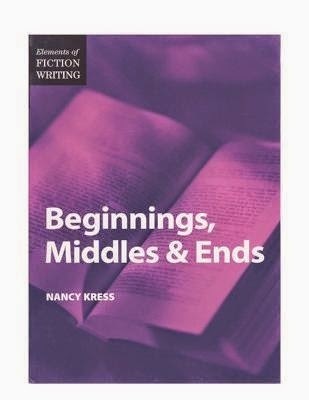 Come back next week for some tips on story making.
Come back next week for some tips on story making. 
General Advice Part II
"Write. If you are going to be a writer, you must write. Many people talk about writing, read books about writing, but do not write. Finish a story. Revise it for a particular market or for your own pleasure. Write daily because it is practice.

"Buy yourself a notebook, preferably one that you can take with you on walks or tuck into your medium sized purse, something that is not a burden but a pleasure. This way, you always have a chance to sit down and collect your thoughts no matter where you are. I find that writing for just 15-20 min a day keeps my writing muscles limber. Vijaya Bodach, author of the upcoming picture book, Ten Easter Eggs.
“Trust your process and never compare yourself to another writer, no good will ever come from that.” Holly Hughes
"Consider that thinking time is writing time, and it may even be more valuable in the end. Mine those moments in the shower where you talk to your character, or the discussion you and your protagonist have while cleaning the toilet. It might be handy to take along a small recorder in the car, to capture these thought-conversations. Take your protagonist (or antagonist for that matter) along to the grocery store and let them choose a few items. Watch how your characters deal with the gym, or church, the doctor’s office or a walk in the neighborhood. Now you are ready to write!" Linda Phillips, author of Crazy .
 From: http://cliparts.co/picture-of-person-... all you can about the submitting, publishing process and then persist, persist, persist! Believe in your story and never give up because if you do, you'll never know how close you came.
From: http://cliparts.co/picture-of-person-... all you can about the submitting, publishing process and then persist, persist, persist! Believe in your story and never give up because if you do, you'll never know how close you came. "Be brave enough to write what makes you feel most strongly. Whether that feeling results in laughter, tears, fear or heartbreak. Because if you don’t feel it while you’re writing, chances are the readers won’t feel it either." Sandra Warren, author of Arlie the Alligator and other books for children and adults.
 From: http://archive.constantcontact.com/fs... in yourself. Submit your manuscripts. Believe that you will receive a contract . Celebrate you. Never Give Up." Joan Edwards, author of the upcoming book, Elder Care Guide.
From: http://archive.constantcontact.com/fs... in yourself. Submit your manuscripts. Believe that you will receive a contract . Celebrate you. Never Give Up." Joan Edwards, author of the upcoming book, Elder Care Guide."Check out resources highly recommended by the writing community: blogs, workshops, book reviews, tips on listservs, etc. Actively participate. Join in discussions, leave comments, enter contests. Priceless opportunities." Linda Andersen. See her Writer's Playground for March post here.
*******Remember, if you leave me a comment with a writing tip that I use, I'll enter your name for a chance to win:
 Come back next week for some tips on story making.
Come back next week for some tips on story making.
Published on March 02, 2015 05:00
February 23, 2015
Writing Tips #1: Nuggets of Wisdom from Writers to Writers
The on-line writing community is rich with resources; I have found many writers are willing to share their knowledge with each other. In the upcoming blogs I'm plan to pass along tips from my fellow writers. Do you have something you have learned as a writer which you would like others to know? Please leave me a comment and I'll consider adding it.
General Advice
I'm going to begin with this post and picture by my Facebook friend, Melodye Shore:
"You can't see the hummingbird hatchlings from this angle; it's not likely you saw her nest, either--at first glance, anyway. And so it is with writing. You have to explore an idea from all angles, examine it from multiple points of view before gaining a full understanding of what it is, exactly, that your story's really about."

If you look closely, you'll see a hummingbird nest in this fuchsia.
Jody Staton, an author and copy editor, posted a great tool on Kathy Temean's blog. Three Editor's Tools for Writers encourages you to compile chapter summaries, a character list, and a style sheet while you're writing your book. This will save you time and energy and help you create a publishable book.
Joyce Hostetter, author of BLUE , COMFORT and HEALING WATER says, "Write no unnecessary words. Actually, go ahead ahead and write them. But when you recognize them, delete fearlessly! And stack each word and sentence for the most powerful impact possible."
Emily Smith Pierce, author of Isabel and the Miracle Baby and SLOWPOKE , says, "Writing usually starts out as a solitary process, but to get better, you need to collaborate. Seek out readers and other writers who will give you honest (yet encouraging) feedback."
Halli Gomez remembers this tidbit she heard from young adult science fiction writer Beth Revis at an SCBWI-Carolinas conference: "If you think you will only have one great idea for a book, don't worry. More will come and they will be even better."
Martina Boone, author of compulsion contributes, "My biggest tip for writers is to read widely, certainly within their chosen age group and genre but also in general. That’s so obvious, but it’s astonishing how many YA (young adult) writers don’t actually read YA, or enough YA, and that’s necessarily not just for marketing, but for knowing your audience and the competition."
At the end of this mini-series of blogs I'm going to giveaway Nancy Kress's book, Beginnings, Middles & Ends. If you leave a comment on my blog with a tip and I use it, I'll enter your name in this giveaway.
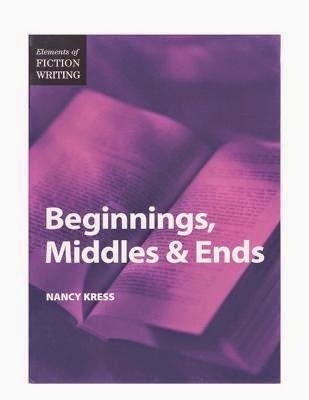

General Advice
I'm going to begin with this post and picture by my Facebook friend, Melodye Shore:
"You can't see the hummingbird hatchlings from this angle; it's not likely you saw her nest, either--at first glance, anyway. And so it is with writing. You have to explore an idea from all angles, examine it from multiple points of view before gaining a full understanding of what it is, exactly, that your story's really about."

If you look closely, you'll see a hummingbird nest in this fuchsia.
Jody Staton, an author and copy editor, posted a great tool on Kathy Temean's blog. Three Editor's Tools for Writers encourages you to compile chapter summaries, a character list, and a style sheet while you're writing your book. This will save you time and energy and help you create a publishable book.
Joyce Hostetter, author of BLUE , COMFORT and HEALING WATER says, "Write no unnecessary words. Actually, go ahead ahead and write them. But when you recognize them, delete fearlessly! And stack each word and sentence for the most powerful impact possible."
Emily Smith Pierce, author of Isabel and the Miracle Baby and SLOWPOKE , says, "Writing usually starts out as a solitary process, but to get better, you need to collaborate. Seek out readers and other writers who will give you honest (yet encouraging) feedback."
Halli Gomez remembers this tidbit she heard from young adult science fiction writer Beth Revis at an SCBWI-Carolinas conference: "If you think you will only have one great idea for a book, don't worry. More will come and they will be even better."
Martina Boone, author of compulsion contributes, "My biggest tip for writers is to read widely, certainly within their chosen age group and genre but also in general. That’s so obvious, but it’s astonishing how many YA (young adult) writers don’t actually read YA, or enough YA, and that’s necessarily not just for marketing, but for knowing your audience and the competition."
At the end of this mini-series of blogs I'm going to giveaway Nancy Kress's book, Beginnings, Middles & Ends. If you leave a comment on my blog with a tip and I use it, I'll enter your name in this giveaway.

Published on February 23, 2015 05:31



